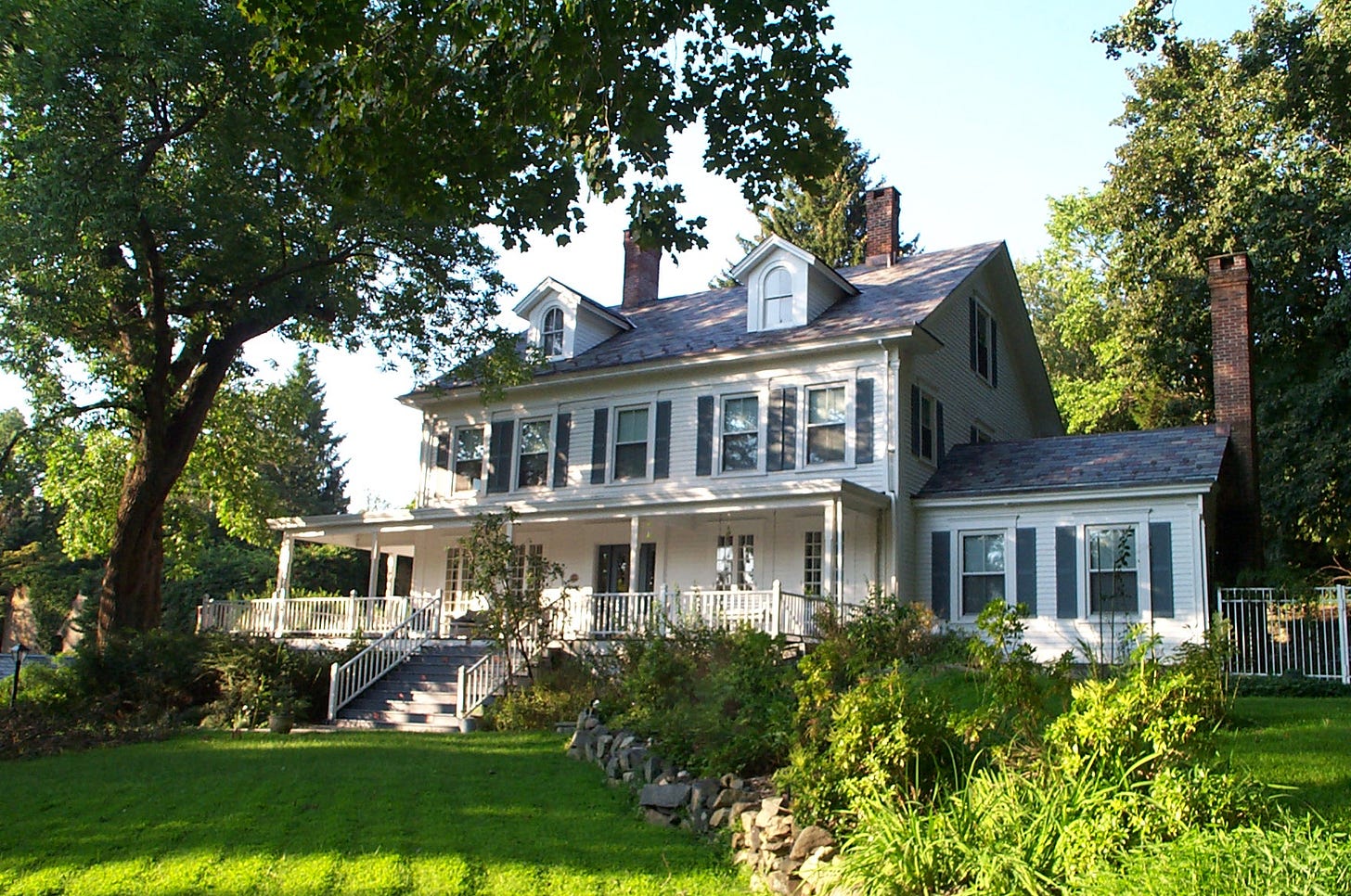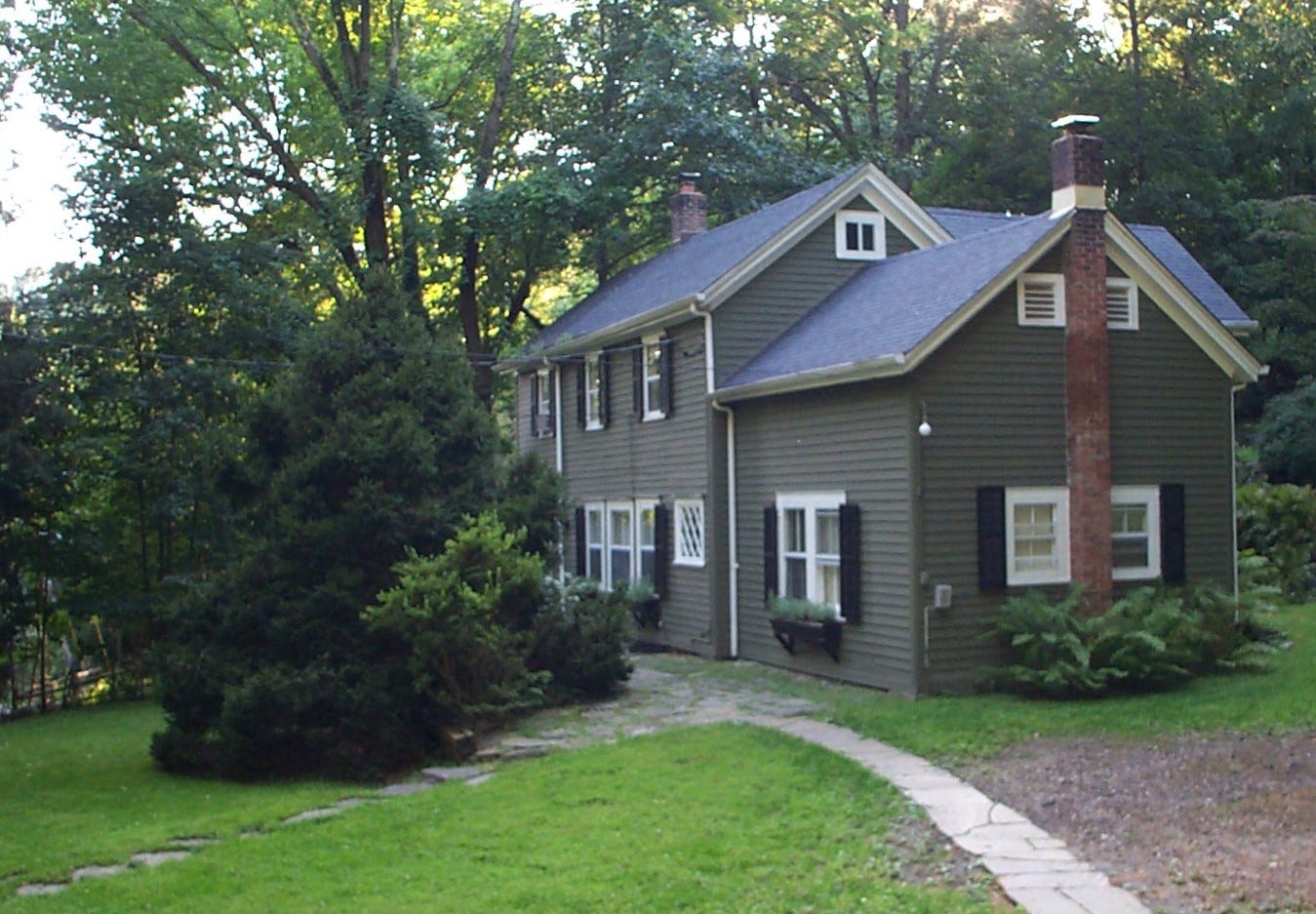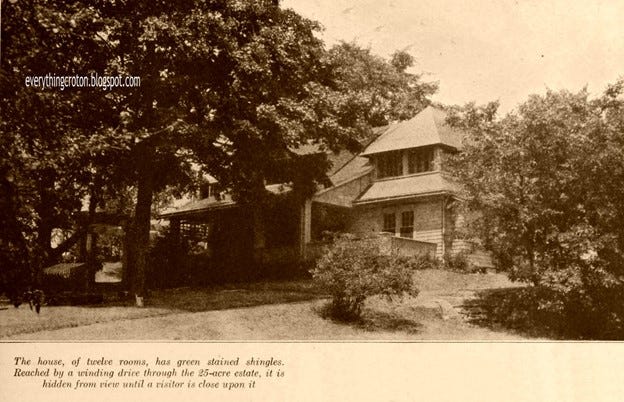A tour of Mount Airy Road and "Red Hill"
A former realtor, and now Managing Editor of The New Croton Review, would take his clients to see these historic houses--and sold a number of them himself.
by Bruce Dollar
Mabel Dodge House, 27 Finney Farm Road (Photo by Bruce Dollar)
Editor’s Note: An earlier version of this article was published by the author in January 2009 in The Gazette.
Early in the last century – the Twentieth, that is – Croton-on-Hudson became a Mecca for New York’s artsy, leftist crowd. Easy access from the City via the new electric trains (which switched back to steam at Harmon, now Croton-Harmon station) enticed both leading lights and fellow travelers – actors, writers, poets, painters and left-wing intellectuals – to build or buy summer or year-round cottages in the hills above the village. By the 1920s there was a thriving Bohemian community centered in Croton, which became known as “Greenwich Village on the Hudson.”
The focal point for this community was Mount Airy Road, which starts in the village downtown and climbs up what old timers still call “Red Hill” for the political leanings of these very particular settlers. A few years ago, long-time Croton resident Cornelia Cotton, artistic and political scion and chronicler of the history of this group, gave a lecture and slide show on historical Mount Airy houses to a standing-room-only audience at the Croton Free Library. She had to stop after 2½ hours and two full carousels of slides, not half-way through her program.
As a realtor with family roots in Croton, I was always fascinated by this history. If I drove by these noteworthy houses with clients in the car, they’d probably get the full guided-tour treatment, even when we were on our way somewhere else. I took special pleasure in showing and selling these homes, and I sold more than my share.
Joseph Freeman, a writer and frequent visitor in the post-World War I period, described the radical colony in his 1936 memoir, An American Testament:
“At this time, Croton-on-Hudson was a kind of literary and political shrine. The sacred grove was a stretch of brown hilly earth known as Mount Airy Road, on both sides of which, separated by an acre or two of land, stood the houses of John Reed, Boardman Robinson, Lydia Gibson, Floyd Dell and Stuart Chase . . . It was some time before I realized that Croton was only a suburb of Washington Square.”
Freeman usually stayed with Floyd Dell, who bought the 1892 farmhouse at 75 Mount Airy Road in 1919. Dell was an influential editor, novelist and literary critic who held virtual salons at his house for visiting radical artists and intellectuals. Freeman recalls a memorable weekend there with Upton Sinclair, author of The Jungle, the muckraking novel about the U.S. meatpacking industry that had led to passage of the Pure Food & Drug Act in 1909. I sold this house to a charming young couple who began restoring it.
Floyd Dell House, 75 Mount Airy Road (Photo by Bruce Dollar)
Next door, at no. 79, lived Robert “Bob” Minor and his wife Lydia Gibson, both activist illustrators who had met as contributors to The Masses, a politically radical magazine combining socialist philosophy with the arts. Another prominent artist who contributed political cartoons to The Masses, William Gropper, built a nine-room stone house – “bourgeois as hell,” as Gropper described it – nearby.
Across the street at no. 66, Boardman Robinson, yet another artist and political cartoonist, lived in a classic center-hall colonial perched high on a bluff with views of the Hudson River. The poet Edna St. Vincent Millay, another frequenter of the Croton colony, was married in this house in 1923.
Boardman Robinson House, 66 Mount Airy Road (Photo by Bruce Dollar)
Next door and up the hill at no. 70 is the 200-year-old house that belonged to Max Eastman, the dashing literary and social critic who was a leader in the radical Greenwich Village community and editor of The Masses. His sister Crystal Eastman, according to local Croton historian Robert Scott, had a house down the hill at no. 71 with her husband Walter Fuller, a British poet and antiwar activist. Crystal was a journalist and a prominent feminist who co-wrote the Equal Rights Amendment in 1923 and was a founding member and lawyer of the ACLU.
Max’s home was the main crossroads for visiting luminaries, including, by some accounts, Charlie Chaplin. Robert Scott, however, debunks this idea as follows:
“The only time Charlie Chaplin was in Croton was a brief visit in 1920 when he stayed at the Tumble Inn roadhouse (the Skyview Nursing Home now occupies the site). At the time, Chaplin and Eastman were contending for the affections of Hollywood actress Florence Deshon. She was living with Eastman and shuttling back and forth between the suitors trying to decide which one she loved. Although she and Chaplin walked together around Croton, Chaplin refused to visit Eastman.”
As a realtor, I was fascinated to discover that when Eastman bought this house, his down payment was twenty dollars, and the purchase price was $1,500. In 2005, it sold for well over the asking price of $799,000.
Around the bend at the top of the hill, at no. 106, stands the 1840 house that John Reed bought in 1916. Reed is best known as the radical journalist who, with his wife Louise Bryant, participated in the Bolshevik Revolution in 1917 and wrote about it in his famous book, Ten Days That Shook the World. Warren Beatty based his great Oscar-winning movie Reds on “Jack” Reed’s story, and part of the film is set in Croton (though it was filmed in England), at the house where Reed wrote his book. Beatty took the role of Reed, of course, Diane Keaton played Bryant, and Floyd Dell was also featured in the screenplay.
Jack Reed House, 106 Mount Airy Road
History might have been different if Mabel Dodge hadn’t turned down Jack Reed’s proposal of marriage early in 1916, the same year he later married Louise Bryant. Dodge was the formidable heiress and patron of the arts who had established a weekly salon at her Fifth Avenue apartment in Greenwich Village. In 1913, she and Reed ran off to Paris, where they became lovers. In Paris, and in Mabel’s palatial Tuscan villa outside Florence, they hobnobbed with the likes of Pablo Picasso, Gertrude Stein and Alice B. Toklas, Arthur Rubenstein, and Andre Gide.
Back in the U.S., Dodge lived in a house on Mount Airy, but when she rebuffed Reed’s marriage proposal, she moved to Finney Farm, not far away in the village. There, in a rambling farmhouse built in 1870, she offered Reed the use of the third floor as a writing studio. He tried it for a time, but it didn’t work out. He then bought her Mount Airy house and, that same year, Mabel married painter Maurice Sterne, her third husband. (1916 must have been quite a year.) Finney Farm already had a rich history when Dodge bought it. Horace (“Go West, young man”) Greeley was just one of the prominent visitors there in the mid-19th century. When I sold this house it was full of documents and other lore evoking this colorful past.
The stories and the history go on and on. Farther along Mount Airy, at no. 131, is another landmark of the time, Longue Vue Farm, the 25-acre estate where Gloria Swanson lived and entertained in the late 1920s. The property name, which refers to its long views down the Hudson, is explained by the fact that, at the time Swanson bought it, she was married to a French Marquis, Henri de la Falaise de la Coudraye. Her residence in Croton coincided, however, with both her notorious three-year affair with the married Joseph P. Kennedy and the era of Prohibition.
This gave rise to some juicy local lore that had Joe Kennedy, a “known” bootlegger, hiding his rum-running trucks from Canada in the large, stone castle-like structure that’s visible from the road. Like lots of stories about celebrities that turn out to be apocryphal, including the one that had Isadora Duncan dancing on the flat roof of the same castle, this one has proven too good to die.
The actual house Swanson lived in, pictured below, burned to the ground shortly after she sold it. Years later, she visited the house that replaced it, a Normandy-style stone farmhouse, driving her convertible up the driveway with her son, unannounced. The castle, a combined guesthouse, wine cave and garage, has endured.
Gloria Swanson House.
Gloria Swanson, it must be said, was hardly in the mold of the lefties on Red Hill. A lifelong Republican, she supported the presidential campaigns of Wendell Willkie against FDR in the 1940s, and Barry Goldwater in 1964. And she chaired the New York chapter of Seniors for Reagan-Bush in 1980. She died in 1983.
Bruce Dollar is Managing Editor of the New Croton Review.
************************************************************************************************************
To share this post, or to share The Croton Chronicle, please click on these links.









Living here for so many years I never fail to love hearing the history of this amazing Village. Thanks for keeping it alive for all to enjoy.
This is an interesting and often forgotten history of Croton. Thanks for sharing. The homes are beautiful and so is the landscape there.